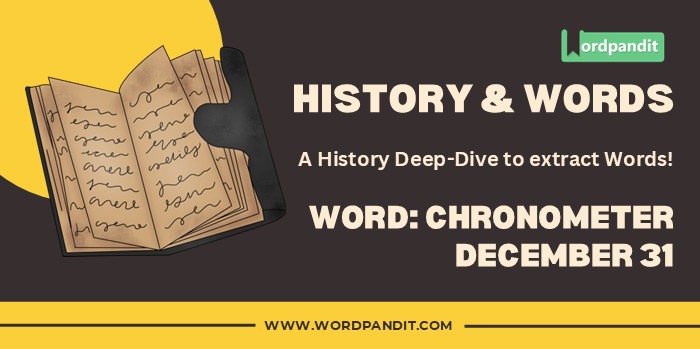History & Words: ‘Chronometer’ (December 31)
Welcome to ‘History & Words.’ 🌟 I’m Prashant, founder of Wordpandit and the Learning Inc. Network. This series combines my passion for language learning with historical context. Each entry explores a word’s significance on a specific date, enhancing vocabulary while deepening understanding of history. Join me in this journey of words through time.
📚 Table of Contents
🔍 Word of the Day: Chronometer
Pronunciation: /krəˈnɒmɪtə/ (kruh-NOM-i-ter)
🌍 Introduction
On December 31, 1879, Thomas Edison’s demonstration of the incandescent light bulb was meticulously timed using a chronometer, highlighting the intersection of precision timekeeping and technological innovation. This historic moment exemplified how accurate time measurement had become crucial to scientific advancement.
The word “chronometer” represents humanity’s quest for precise time measurement, embodying centuries of technological development in the pursuit of accuracy. Unlike simple timepieces, chronometers are instruments of exceptional precision.
From maritime navigation to modern scientific research, chronometers have played a vital role in human progress, enabling discoveries and innovations that shaped our world.
🌱 Etymology
The term “chronometer” comes from the Greek words “chronos” (time) and “metron” (measure). It was first used in the early 18th century to describe precise timepieces, particularly those designed for determining longitude at sea.
📖 Key Vocabulary
- 🔑 Horology: The study and measurement of time
- 🔑 Escapement: The mechanism that controls a timepiece’s moving parts
- 🔑 Longitude: Geographic coordinate measuring distance east or west
- 🔑 Isochronous: Occurring at regular intervals
🏛️ Historical Context
Ancient civilizations used sundials and water clocks for timekeeping, but the need for more precise measurement grew with maritime exploration.
The 18th century’s longitude problem spurred the development of marine chronometers, with John Harrison’s H4 chronometer (1761) revolutionizing naval navigation.
The Industrial Revolution demanded increasingly precise time measurement, leading to further chronometer innovations that supported scientific advancements and industrial efficiency.
⏳ Timeline
- 1714: Longitude Act offers prize for accurate navigation
- 1761: Harrison completes H4 chronometer
- 1879: Edison’s demonstration (December 31)
- 1884: International Meridian Conference
- 1967: Atomic clock defines the second
- 1972: Coordinated Universal Time (UTC) established
- 2015: Optical atomic clocks achieve new precision records
- 2023: Quantum chronometers development
🌟 The Day’s Significance
December 31, 1879, marked not only Edison’s breakthrough but also demonstrated how precise timekeeping had become integral to scientific progress. The chronometer used that evening helped document the duration of the light bulb’s illumination.
This convergence of timekeeping and innovation reflected the increasingly technical nature of scientific discovery in the late 19th century. Accurate time measurement was now essential for documenting and validating scientific achievements.
💬 Quote
“Time and its accurate measurement are the heart of both science and civilization.” – John Harrison
🔮 Modern Usage and Reflection
Today’s chronometers range from precision mechanical watches to atomic clocks that lose less than a second in millions of years.
Modern applications include GPS systems, financial trading, and scientific research, where precise timing remains crucial. Chronometers continue to evolve, bridging the gap between tradition and cutting-edge technology.
🏛️ Legacy
The chronometer’s legacy extends beyond timekeeping into numerous fields requiring precise measurement and synchronization. Its development contributed to standardized time zones, global navigation systems, and modern scientific methodology.
🔍 Comparative Analysis
While early chronometers focused on mechanical precision, modern versions employ quantum physics and atomic resonance. This evolution demonstrates the shift from mechanical to quantum timekeeping, reflecting advancements in technology and science.
💡 Did You Know?
🎓 Conclusion
The chronometer stands as a testament to humanity’s quest for precision and understanding. Continuing to evolve as technology advances, it maintains its essential role in science and navigation, enabling progress across numerous fields.
📚 Further Reading
- 📘 “Longitude: The True Story of a Lone Genius Who Solved the Greatest Scientific Problem of His Time” by Dava Sobel
- 📗 “The Quest for Accurate Time and the Navigation Problem” by William J.H. Andrewes
- 📙 “Time’s Pendulum: The Quest to Capture Time” by Jo Ellen Barnett











